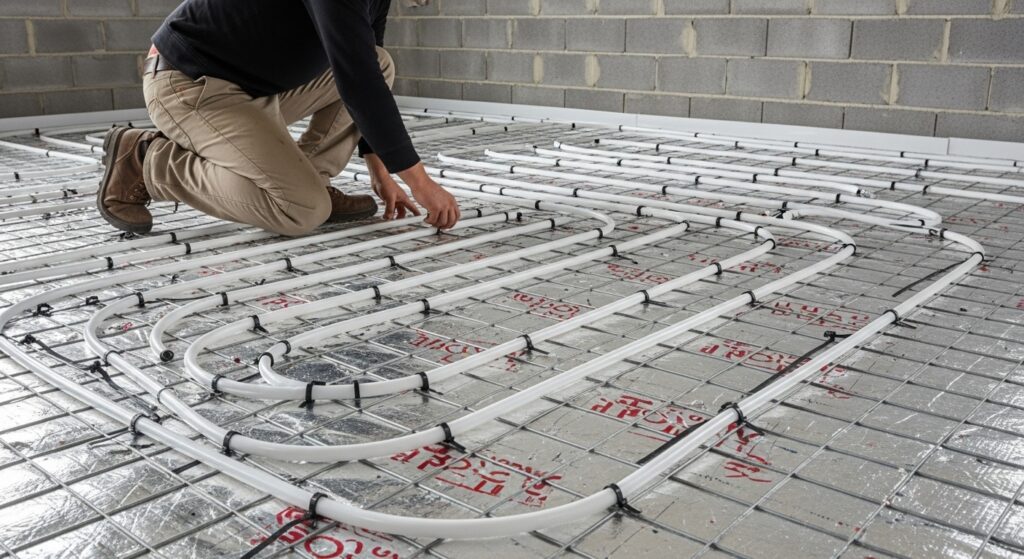Underfloor heating has become a popular choice in homes across the UK, offering an efficient, comfortable, and invisible way of keeping spaces warm. Whether electric or water-based, these systems are valued for their consistent heat and modern appeal. But ask any heating engineer, and they’ll tell you the same thing: the majority of repair call-outs happen in winter.
So why do underfloor heating systems seem to fail more often in the colder months? And more importantly, what can you do to prepare early so you’re not left with cold feet on a frosty January morning?
Let’s explore the reasons behind this seasonal surge in repairs – and practical steps to ensure your system is ready before winter strikes.

1. Why Underfloor Heating Repairs Peak in Winter
Higher Demand on the System
During autumn and winter, underfloor heating systems are switched on more frequently and for longer periods. This sudden, heavy demand after months of inactivity puts strain on components such as thermostats, wiring, and pipework.
Dormancy Issues
Many homeowners turn off their heating entirely during spring and summer. Months of disuse can allow minor faults to go unnoticed, only becoming apparent when the system is restarted in colder weather.
Flooring and Insulation Changes
Cold weather changes the way flooring materials expand and contract. Tiles, wood, and stone respond differently to temperature shifts, which can put additional stress on heating elements or pipework beneath.
Ageing Systems Under Pressure
Older systems that are already close to the end of their lifespan often give up in winter when the strain of near-constant use is at its peak. What might have been a small inefficiency in October can turn into a complete breakdown by December.
2. Common Winter Heating Problems
Understanding the typical issues that crop up in colder months can help you spot warning signs early. Some of the most common winter faults include:
- Uneven heating: cold patches on the floor caused by cable damage or airlocks in water pipes.
- Faulty thermostats: often misreading temperatures or failing to respond to settings.
- Electrical faults: wiring problems or damaged heating mats revealed when the system is under heavy use.
- Leaks in water-based systems: increased pressure during continuous winter operation can highlight weaknesses in pipework.
- Slow heat-up times: often linked to insulation issues or reduced system efficiency.
3. The Cost of Waiting Until Winter
Leaving underfloor heating checks until the cold season can be costly for several reasons:
- Longer waiting times: Engineers are busier in winter, meaning slower response times and fewer appointment slots.
- Higher costs: Emergency call-outs during peak season are often more expensive.
- Limited parts availability: With demand at its highest, sourcing specific replacement parts may take longer.
- Increased discomfort: Living without heating in winter is far more inconvenient than in spring or summer.
4. How to Prepare Early
The best way to avoid a winter breakdown is to plan ahead. Here are practical steps to keep your underfloor heating in top shape:
Test the System in Autumn
Switch your system on in early autumn, before temperatures drop significantly. Look out for cold patches, unusual noises, or slow performance. This gives you time to fix issues before you actually need the heating daily.
Schedule a Professional Service
Arrange for a qualified underfloor heating engineer to inspect your system annually. They can run diagnostic tests, check wiring or pipework, and ensure thermostats and controls are working properly.
Bleed and Balance Water Systems
If you have a hydronic (water-based) system, ensure airlocks are cleared and the pressure is balanced. This prevents uneven heating and system inefficiency.

Check Floor Coverings and Insulation
Rugs, thick carpets, or poorly fitted flooring can affect heat distribution. Make sure your floor coverings are suitable and that insulation is still performing as intended.
Update Your Thermostat Controls
Smart thermostats and programmable timers can help reduce strain on the system by optimising usage. If your system still runs on outdated controls, consider upgrading before winter.
5. The Benefits of Early Preparation
Being proactive not only prevents uncomfortable surprises but also delivers several long-term benefits:
- Lower repair costs: Small issues caught early are cheaper to fix.
- Improved energy efficiency: A well-maintained system runs more effectively, reducing bills.
- Extended system lifespan: Regular maintenance prevents premature wear and tear.
- Peace of mind: You’ll enter winter knowing your system is reliable.
6. Real-World Example: A Tale of Two Households
Consider two families in London.
- The first switched on their underfloor heating for the first time in November, only to find half the living room floor was cold. With engineers fully booked, they waited two weeks for a repair and spent hundreds on portable heaters in the meantime.
- The second family tested their system in September. When they noticed the thermostat was unresponsive, they had it replaced immediately. By the time December arrived, their home was cosy, efficient, and stress-free.
This simple contrast shows just how important early preparation can be.
Conclusion
Underfloor heating is a fantastic investment in comfort, but like any system, it needs attention. Repairs peak in winter because that’s when systems are under the most strain – and when homeowners rely on them most.
By preparing early, testing your system in autumn, and booking professional maintenance ahead of the cold season, you can save money, avoid stress, and ensure your home stays warm and inviting all winter long.
So don’t wait until the frost sets in. Take action today – your future self (and your toes) will thank you.
